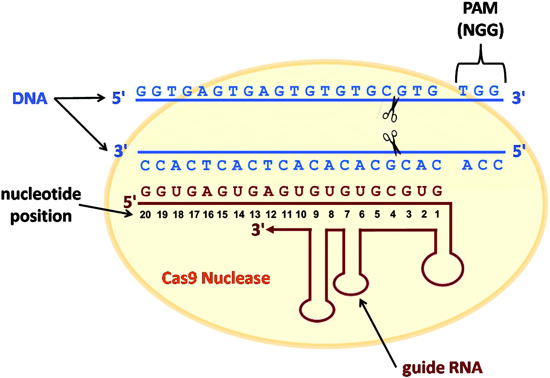Doug Auld, Ph.D. Novartis Institutes for BioMedical Research
Researchers use a human cell-based reporter assay to characterize off-target cleavage of CRISPR-associated (Cas)9-based RNA-guided nucleases.
Gene editing is a method to introduce double-stranded breaks into DNA in a controlled manner and has been applied to construct engineered cell lines in which insertions/deletions (so called indel mutations) are introduced into genes at a specific site. There are three gene editing methods currently available: two techniques employ peptides that recognize specific DNA sequences linked to a nonspecific nuclease, zinc finger nuclease (ZFN) and transcription activator-like effector nuclease (TALENs), and a third, newer technique uses clustered, regularly interspaced, short palindromic repeat (CRISPR) RNA-guided nucleases (RGNs). All three techniques can be used to introduce foreign DNA into a specific site by exploiting the cells’ natural response to DNA double-stranded breaks, which includes nonhomologous end joining (NHEJ) mechanisms.
In CRISPRs, an RGN from Streptococcus pyogenes (Cas9) is used. Cas9 requires a 20-nucleotide RNA guide (gRNA) sequence that is complementary to the target genomic DNA sequence where this sequence is adjacent to a NGG motif. The only other sequence requirement for CRISPR is that the first nucleotide of the gRNA is a G, but this is due to a requirement of the U6 promoter needed to express the RNA (Figure). Therefore, CRIPSRs provide a very flexible method to introduce double-stranded breaks into DNA. However, a central concern with gene editing techniques is the number of off-target double-stranded breaks that may be introduced.
This article* examines the specificity of the gRNAs used in CRISPR by monitoring the NHEJ-mediated repair of an EGFP-PEST reporter introduced as a single copy into cells. With this reporter gene assay, indel mutations can be monitored through the loss of GFP fluorescence.
In the study, three gRNAs were used against separate regions of the GFP gene. Variants of these gRNAs containing various nucleotide mismatches across the 20-nucleotide region were then constructed and tested by comparing the amount of GFP expression to wild-type sequences. This showed that mismatch tolerances depended on the target site, with site 2 being very intolerant to mutations in the 3′ end of the sequences, while sites 1 and 3 were tolerant to single-nucleotide mismatches except for a few sites at the 3′ end; the specific sites that were sensitive differed between target sites. Therefore, tolerances to mismatches were more sensitive at the 3′ end, consistent with previous reports, but the relative amount of tolerance was target site specific.
Next, the study looked for off-target mutations in endogenous genes. Six single gRNAs were used to target four different genes, and these were shown to efficiently introduce indel mutations into their target genes. However, examination of genomic loci that differed by one or two nucleotides (as well as genomic sites differing by three or six nucleotides, particularly in the 5′ end) showed high rates of off-target mutations. Rates of mutations at these sites for two of the four genes in U2OS, HEK293, and K562 cells ranged from a small percentage of the target gene to >125% of the target gene.
The rates of off-target mutations did not improve by expression of lower amounts of single gRNAs or Cas9. This article cautions that predicting such off-target mutations with CRISPR will not be easy because it appears to be target site specific, and this will be have to be carefully evaluated when constructing cell lines with this technology.

Figure. Schematic illustrating a sgRNA/Cas9 nuclease complex bound to its target DNA site. Scissors indicate approximate cleavage points of the Cas9 nuclease on the genomic DNA target site. Note the numbering of nucleotides on the guide RNA proceeds in an inverse fashion from 3′ to 5′.
*Abstract from Nature Biotechnology 2013 June 23 [Epub ahead of print]; DOI: 10.1038/nbt.2623
Clustered, regularly interspaced, short palindromic repeat (CRISPR) RNA-guided nucleases (RGNs) have rapidly emerged as a facile and efficient platform for genome editing. Here, we use a human cell–based reporter assay to characterize off-target cleavage of CRISPR-associated (Cas)9-based RGNs. We find that single and double mismatches are tolerated to varying degrees depending on their position along the guide RNA (gRNA)-DNA interface. We also readily detected off-target alterations induced by four out of six RGNs targeted to endogenous loci in human cells by examination of partially mismatched sites. The off-target sites we identified harbored up to five mismatches and many were mutagenized with frequencies comparable to (or higher than) those observed at the intended on-target site. Our work demonstrates that RGNs can be highly active even with imperfectly matched RNA-DNA interfaces in human cells, a finding that might confound their use in research and therapeutic applications.
Want more on gene editing? Be sure to check out GEN’s new eBook, Gene Editing: Improving Life Science Research One Modification at a Time.
Doug Auld, Ph.D., is affiliated with the Novartis Institutes for BioMedical Research.
ASSAY & Drug Development Technologies, published by Mary Ann Liebert, Inc., offers a unique combination of original research and reports on the techniques and tools being used in cutting-edge drug development. The journal includes a “Literature Search and Review” column that identifies published papers of note and discusses their importance. GEN presents here one article that was analyzed in the “Literature Search and Review” column, a paper published in Nature Biotechnology titled “High-frequency off-target mutagenesis induced by CRISPR-Cas nucleases in human cells.” Authors of the paper are Fu Y, Foden JA, Khayter C, Maeder ML, Reyon D, Joung JK, and Sander JD.



